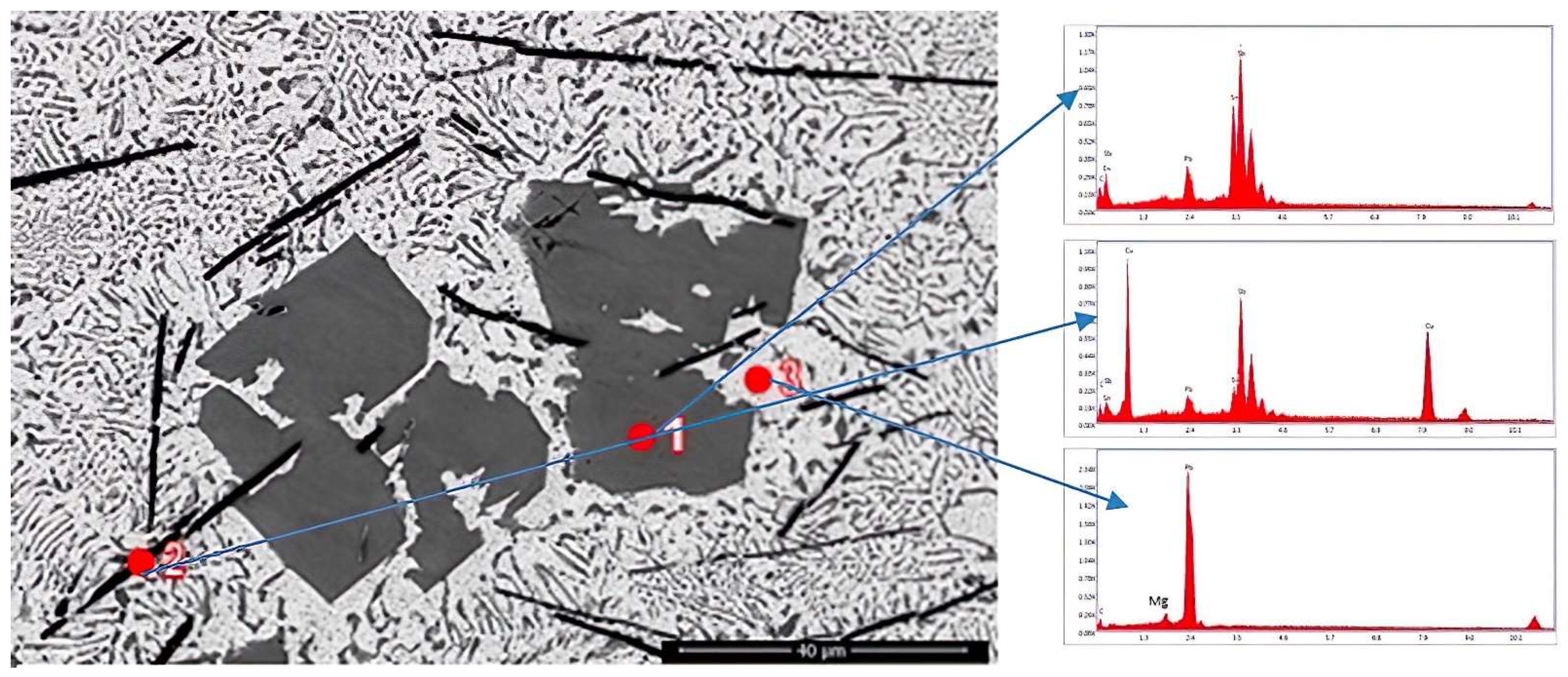The Effect of Ca and Mg on the Microstructure and Tribological Properties of YPbSn10 Antifriction Alloy
Abstract
:1. Introduction
2. Materials and Methods
2.1. Materials
| Alloy | Sample |
| YPbSn10Ca0.2 | YP1 |
| YPbSn10Mg0.2 | YP2 |
2.2. Tribological Tests
3. Results and Discussions
3.1. Structural Characterization
3.2. Tribological Tests
4. Conclusions
Author Contributions
Funding
Conflicts of Interest
References
- Guruswamy, S. Engineering Properties and Applications of Lead Alloys; Marcel Dekker Inc.: New York, NY, USA, 2000. [Google Scholar]
- Majdanczuk, T.B.; Iljuszenko, W.M.; Bondarenko, A.N. Effect of modifying and alloying elements on the structure and properties of surfaced layers made of high-tin bronze. Biul. Inst. Spaw. 2017, 61, 39–43. [Google Scholar] [CrossRef] [Green Version]
- Roik, T.A.; Kholyavko, V.V.; Vitsuk, Y.Y. Influence of mechanism tribosynthesis of secondary structures for properties of antifriction composites materials based on nickel. J. Met. Phys. Nov. Technol. 2009, 31, 1001–1016. [Google Scholar]
- Roik, T.A.; Gavrish, A.P.; Kirichok, P.A.; Vitsyuk, Y. Effect of secondary structures on the functional properties of high-speed sintered bearings for printing machines. Powder Metall. Met. Ceram. 2015, 54, 119–127. [Google Scholar] [CrossRef]
- Liu, S.; Wang, Y.; Muthuramalingam, T.; Anbuchezhiyan, G. Effect of B4C and MOS2 reinforcement on micro structure and wear properties of aluminum hybrid composite for automotive applications. Compos. Part B Eng. 2019, 176, 107329. [Google Scholar] [CrossRef]
- Jamroziak, K.; Roik, T.; Gavrish, O.; Vitsiuk, I.; Lesiuk, G.; Correia, J.A.; De Jesus, A. Improved manufacturing performance of a new antifriction composite parts based on copper. Eng. Fail. Anal. 2018, 91, 225–233. [Google Scholar] [CrossRef]
- Deng, J.; Cao, T. Self-lubricating mechanisms via the in situ formed tribofilm of sintered ceramics with CaF2 additions when sliding against hardened steel. Int. J. Refract. Met. Hard Mater. 2007, 25, 189–197. [Google Scholar] [CrossRef]
- Nedeloni, M.D.; Nedeloni, L.; Cîndea, L.; Iancu, V.; Petrica, A.V.; Budai, A.M.; Conciatu, I.L. Aspects concerning the cavitation erosion and dry sliding wear behavior of the YSn83 antifriction alloy and EN-GJS-400-15 spheroidal cast iron. IOP Conf. Ser. Mater. Sci. Eng. 2019, 477, 012060. [Google Scholar] [CrossRef]
- Nedeloni, L.; Korka, Z.-I.; Nedeloni, M.-D.; Conciatu, I.L. Dry Sliding Wear behavior of some Cu and Al Alloys. Ann. Eftimie Murgu Univ. Resita 2018, 25, 69–80. [Google Scholar]
- Wang, Z.; Zhang, G.; Kang, Y.; Liu, Y.; Ren, X. The Effect of Y on the Microstructure, Mechanical and Wear Properties of ZCuSn10Pb10 Alloy. Materials 2022, 15, 1047. [Google Scholar] [CrossRef] [PubMed]
- Amanov, A.; Ahn, B.; Lee, M.G.; Jeon, Y.; Pyun, Y.S. Friction and Wear Reduction of Eccentric Journal Bearing Made of Sn-Based Babbitt for Ore Cone Crusher. Materials 2016, 9, 950. [Google Scholar] [CrossRef] [PubMed] [Green Version]
- Leszczyńska-Madej, B.; Madej, M.; Hrabia-Wisnios, J. Effect of Chemical Composition on the Microstructure and Tribological Properties of Sn-Based Alloys. J. Mater. Eng. Perform 2019, 28, 4065–4073. [Google Scholar] [CrossRef] [Green Version]
- Zeren, A.; Feyzullahoglu, E.; Zeren, M. A study on tribological behavior of tin-based bearing material in dry sliding. Mater. Des. 2007, 28, 318–323. [Google Scholar] [CrossRef]
- Avram, V.; Semenescu, A.; Csáki, I. Y-PbSn10 antifriction alloys microalloyed with mischmetal. U.P.B. Sci. Bull. Ser. B 2021, 83, 307–312. [Google Scholar]










| Sample | Pb | Cu | Sb | Sn | Zn | Fe | Al | Ni | Mo | Ca | Mg | Others * |
|---|---|---|---|---|---|---|---|---|---|---|---|---|
| YP1 | bal | 1.03 | 13.5 | 8.7 | <0.02 | <0.02 | <0.02 | <0.02 | <0.02 | 0.23 | - | <0.01 |
| YP2 | bal | 1.19 | 13.9 | 7.1 | <0.02 | <0.02 | <0.02 | <0.02 | <0.02 | - | 0.21 | <0.01 |
| Sample | Loading Force Fz | Relative Sliding Speed | ||
|---|---|---|---|---|
| 0.1 mm/s | 0.5 mm/s | 1 mm/s | ||
| YP1: YPbSn10-Ca-2 | 5 N | 0.0871 | 0.1015 | 0.0916 |
| 10 N | 0.0989 | 0.1021 | 0.1074 | |
| 15 N | 0.1033 | 0.1126 | 0.1097 | |
| YP2: YPbSn10-Mg-2 | 5 N | 0.1007 | 0.1159 | 0.1286 |
| 10 N | 0.0975 | 0.1153 | 0.1190 | |
| 15 N | 0.1013 | 0.1008 | 0.1410 | |
| YP3: YPbSn10 | 5 N | 0.1198 | 0.1255 | 0.1310 |
| 10 N | 0.1144 | 0.1252 | 0.1254 | |
| 15 N | 0.1242 | 0.1243 | 0.1344 | |
Publisher’s Note: MDPI stays neutral with regard to jurisdictional claims in published maps and institutional affiliations. |
© 2022 by the authors. Licensee MDPI, Basel, Switzerland. This article is an open access article distributed under the terms and conditions of the Creative Commons Attribution (CC BY) license (https://creativecommons.org/licenses/by/4.0/).
Share and Cite
Avram, V.; Csaki, I.; Mates, I.; Stoica, N.A.; Stoica, A.-M.; Semenescu, A. The Effect of Ca and Mg on the Microstructure and Tribological Properties of YPbSn10 Antifriction Alloy. Materials 2022, 15, 3289. https://doi.org/10.3390/ma15093289
Avram V, Csaki I, Mates I, Stoica NA, Stoica A-M, Semenescu A. The Effect of Ca and Mg on the Microstructure and Tribological Properties of YPbSn10 Antifriction Alloy. Materials. 2022; 15(9):3289. https://doi.org/10.3390/ma15093289
Chicago/Turabian StyleAvram, Vasile, Ioana Csaki, Ileana Mates, Nicolae Alexandru Stoica, Alina-Maria Stoica, and Augustin Semenescu. 2022. "The Effect of Ca and Mg on the Microstructure and Tribological Properties of YPbSn10 Antifriction Alloy" Materials 15, no. 9: 3289. https://doi.org/10.3390/ma15093289
APA StyleAvram, V., Csaki, I., Mates, I., Stoica, N. A., Stoica, A.-M., & Semenescu, A. (2022). The Effect of Ca and Mg on the Microstructure and Tribological Properties of YPbSn10 Antifriction Alloy. Materials, 15(9), 3289. https://doi.org/10.3390/ma15093289







